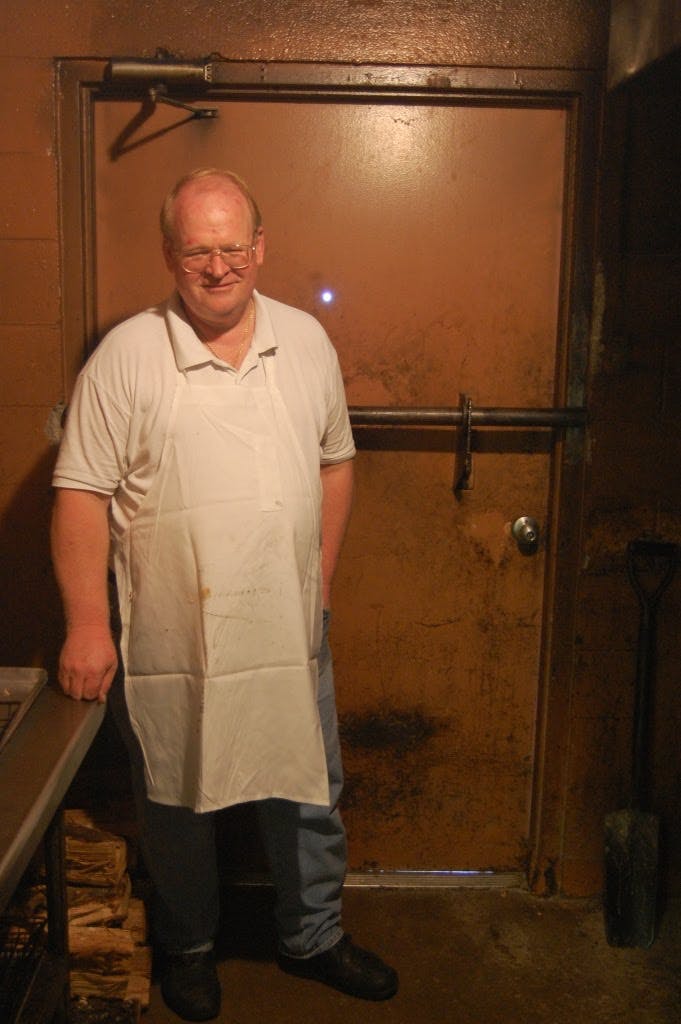 Owner/Pitmaster: Mac’s Bar-B-Que; Opened 1955 (1982 in current location)
Owner/Pitmaster: Mac’s Bar-B-Que; Opened 1955 (1982 in current location)
Age: 60
Smoker: Indirect Heat Wood-Fired Pit
Wood: Hickory
The McDonalds have been a fixture in the Dallas barbecue scene since 1949. Mac’s has moved around a bit, but Billy McDonald has no plans to leave his current spot on Main Street just outside Deep Ellum. He sat down with me at one of the tables inside after he’d completed lunch service. His partner, and the only other employee at Mac’s, Deb Shultz cleaned the last few tables and put away the food for the night while Billy and I talked. He is a second generation barbecue man who remembers life in his father’s restaurants vividly. The interview was so rich with content, that we’re splitting it into two parts. This first segment will examine a slice of Dallas barbecue history as seen through Billy’s father, Bill “Mac” McDonald.
Daniel Vaughn: You took over this business from your father Bill McDonald, but how did he get into barbecue?
Billy McDonald: He got out of World War II as a B-17 electrician. He was stationed in Morocco. He went to school for air conditioning and refrigeration and didn’t like it, so he went to work for Good Luck service stations. One day a guy came in and said “I need somebody to help me with my business. Do you know anyone who needs a job.” My dad asked what the job was and he said it was to help run a barbecue restaurant. My dad asked “what are you paying?” He says “right now I’m paying fifty cents an hour.” My dad says “where is this job located?” Within about two days my dad was working for Green’s BBQ in Dallas. He learned the trade from Mr. Green. He went from there to a place in Preston Center. He was making $70 a week back then which was big money. One day he went to the Mercury dealership in downtown Dallas and brought a brand new 1949 metallic red convertible and he put in leopard print seat covers. He came home and my mom said “what in the hell did you do now?” Before he died he said “man, I wish I had that Mercury back.”
DV: What did he drive when you came around?
BM: He had a 1954 Ford station wagon.
DV: That’s a rough transition.
BM: Well, all the seats went down, so that was his catering vehicle too.
DV: When did he start his own business?
BM: 1949. The same year they put up the clock tower on the Mercantile Building. His first place was located at the intersection of Young and St. Paul in downtown Dallas in an old tin building with clay floors. It was called Young’s Barbecue.
DV: What did he serve back then?
BM: Chopped beef, beans, Fritos and glass bottle drinks. Every morning, the drink people would come by and ice his drinks down for him.
DV: How big was the place?
BM: Probably no bigger than the dining room we’re in now which is about twenty-five feet by twenty-five feet. That was a pretty decent barbecue house back then. One on side of the building was a little room that had nickel slot machines. Every Tuesday some guys in a big fancy black Cadillac would come by. They’d go back in that room and lock the door and pour those nickels out. When they left they’d hand him and $40 or $50 check. Back then that was big money to get once a week.
DV: Was gambling legal in Texas then?
BM: Yes. Nickel slots were still down along the boardwalk in Galveston and a lot of other places.
DV: Did the other barbecue places in town have a similar menu?
BM: Everybody had the same menu. Back in those years you didn’t have barbecued briskets. They did navel plates. Those things weighed thirty pounds apiece. You’d get them delivered and they were wrapped up in butcher paper. You’d get six or seven of them. It would take two days to cook them.
DV: Where did the meat come from?
BM: He was buying them from Farmer’s Meat Market at the time. It was down in the Farmers Market area. The man who owned it was named Harry Rosenthal. His daughter married a young man named Al Plaskoff who now owns Big Al’s Smokehouse. Al worked for Harry and he sold meat to my dad.
DV: What a coincidence. So, how long did Young’s Barbecue operate?
BM: Until December of 1954. We opened up at the corner of Main and Exposition in January of 1955. It’s was called Mac’s Bar-B-Q then. Look at this menu [pointing to the photo below]. A beef basket was thirty-five cents and fries were fifteen cents. That menu there was made by Schepps Dairy. They had a sign department and they’d make you a sign if they could put their logo on it.
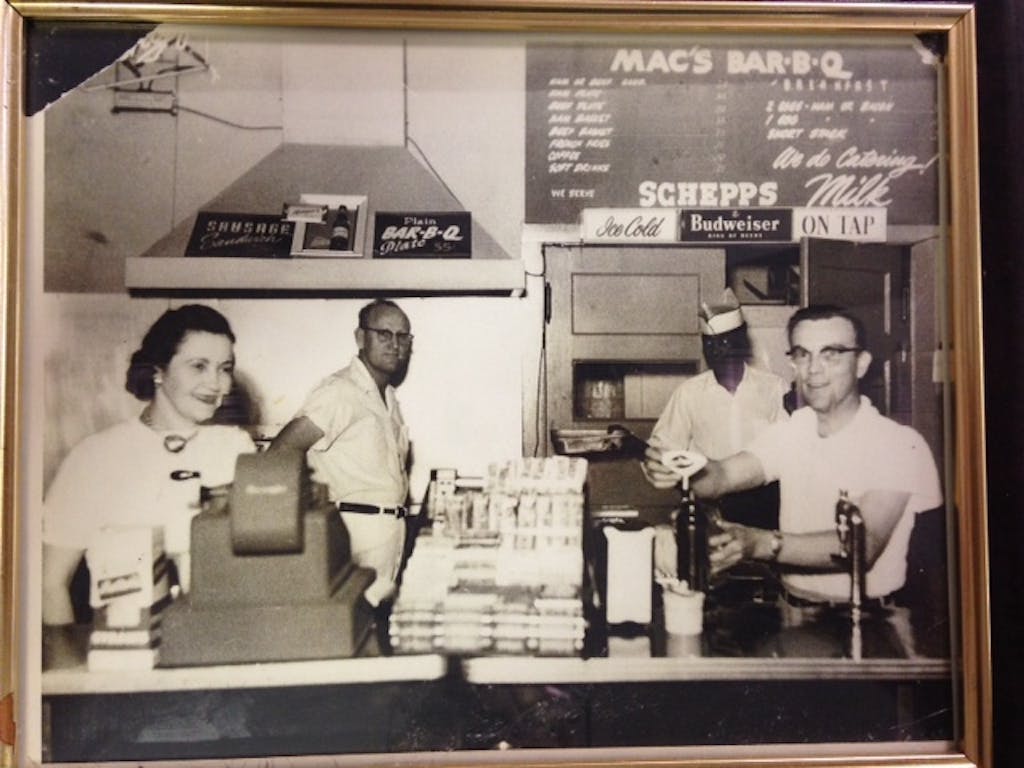
DV: What was the building used for before your dad moved in?
BM: It was Joe’s Famous Barbecue. Joe Fry and Joe Fry Jr. ran it. When Joe Fry passed on from a stroke in 1954, Junior bought it. That’s when my dad got interested. We bought the business from them and they kept the building, so we leased it.
DV: When did Joe’s open?
BM: Joe’s was around from the mid-twenties. I have a photo of the Joe’s over on Exposition from 1936 with FDR in front. Barbecue has been in this area of Dallas for a long time.
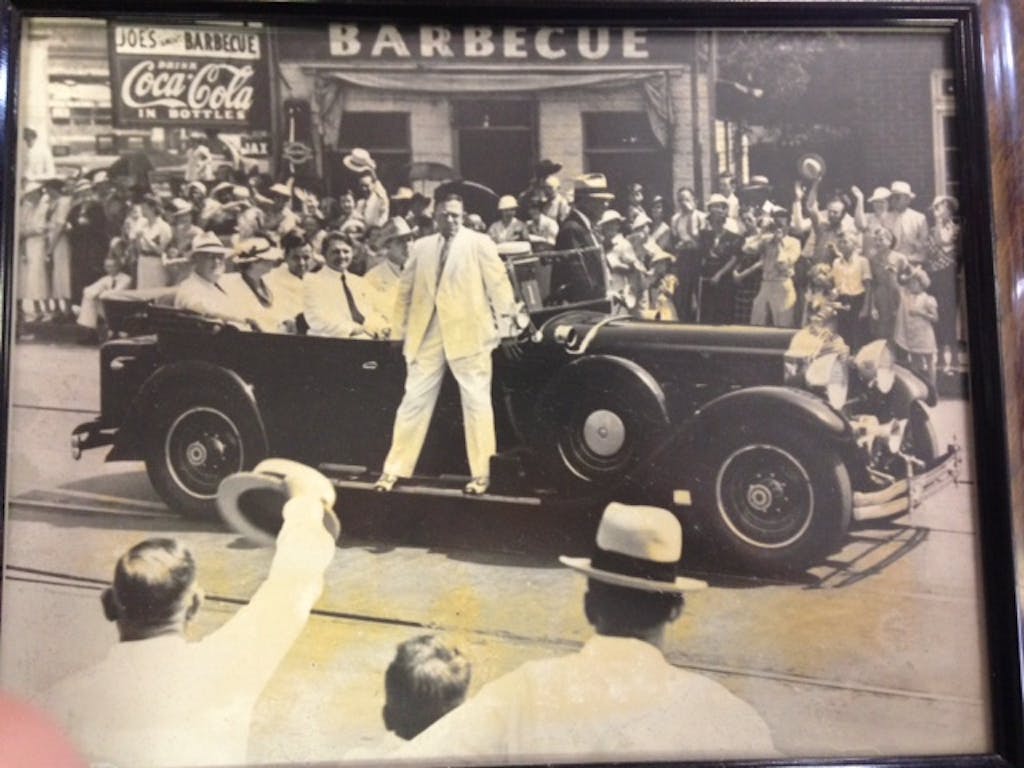
DV: How long did you operate in that building?
BM: We were there from 1955 until about 1967. I can still remember sitting there on the wood pile with my dad watching the old GM electric busses go by. They’d make that corner there and sparks would fly. You could smell them coming.
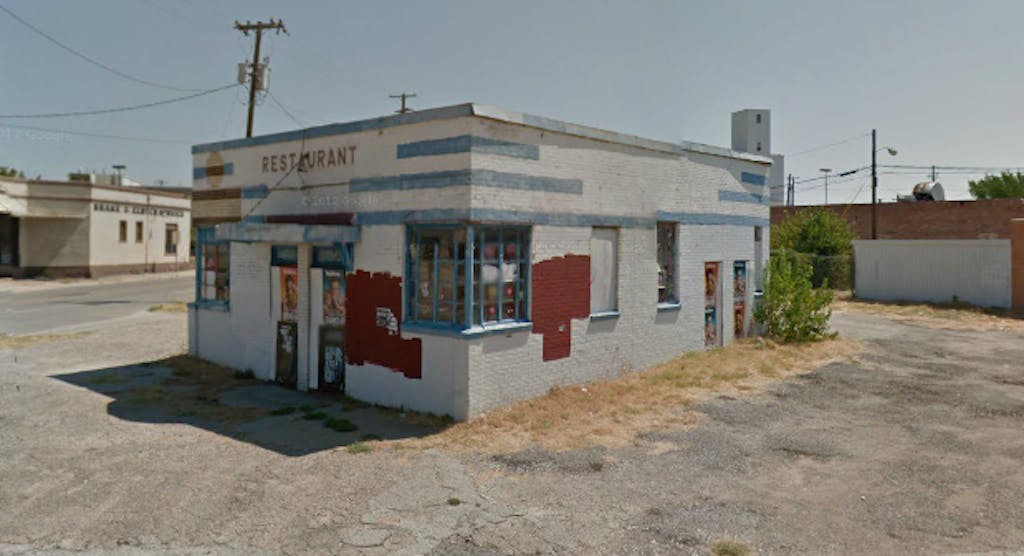
DV: I see those fries on the menu. Was it common then for barbecue joints to have a fryer?
BM: Oh yes.
DV: And he was cooking navel plates then?
BM: Yes. It came bone in. You have to understand, this piece of meat was huge. About a third of it was bone. You had to cook it one day to pre-cook it. Then you’d flip it over and take a paring knife and cut away the bone and strapping out before you could finish cooking it. All the barbecue in those years was served chopped because you couldn’t slice it. It was very fatty meat.
DV: It would look like the cross section of a beef short rib, right?
BM: That’s correct. It cost about a nickel a pound. My dad would go through so many that he had a lot of waste. He had ten barrels at a time in the back. One was for rendered oil, one for trim fat, and another for bone. The beef company would come pick it up and he would get grease checks once a month from Valcar [a beef rendering plant in Dallas]. He would get $35 or $40 a month.
DV: Was he still getting the nickel slot checks too?
BM: No. They were pretty well outlawed by 1951. The Baptists got the laws changed.
DV: What did the restaurant look like inside?
BM: There was a dividing wall between the kitchen and the dining room. On the kitchen side was a small platform for bench seating. My mom was the waitress in the table seating area. We also had two 2-ton window unit air conditioners. It was a big deal to go into a restaurant with refrigerated air. He also bought a flake ice machine. People would come in to see the ice and say “Wow!” They just came in to get a cup of ice.
DV: How did the menu change along the way?
BM: By then we had beef, ham and sausage. The hams he bought were canned, cured hams. My dad would take a pair of channel lock pliers and pull the top off of the can. It was the best damn thing you could put in your mouth. They were really good hams. Back in those years he had a brick pit. The damn thing caught on fire all the time. It was a hot pan pit and it would drain grease into the fire box.
DV: What wood did he use?
BM: He was using hickory. We never have used anything else in our lives. I tell people who ask that we use railroad ties, just to mess with them.
DV: The neighborhood here is a little devoid of businesses these days. What did it look like back then?
BM: Back then there was Sherwin Williams paint, the John E. Mitchell Company and a bunch of others.
DV: Was catering a big part of the business?
BM: Oh yeah. I remember a good story. One day they got a catering job from one of the lodges. Kenneth Bellamy worked for him then, and he and Kenneth went to the lodge and started setting up. All of a sudden four or five gals show up in the kitchen and start stripping down. Kenneth said “Mac, they’re taking their clothes off.” My dad replied “Kenneth, don’t worry about it. They’re just here to work too.” It ended up that they were just fan dancers. Kenneth went on to open Bellamy’s BBQ in downtown Garland.
DV: Who were the other big customers then?
BM: We would do company picnics in September. We’d have them on the Midway at the fairgrounds. My dad knew Arthur Hale who was the Executive Secretary of the State Fair. We would rent the midway. They’d have dunk tanks opened up.
DV: Did they get the executives in there?
BM: No. This was back on the dark side. They used to put black men in there. They had a microphone that they would taunt the employees. “Come on white boy. You can’t hit it. You missed that target!” That was the shady side of Dallas. They’d also have the roller coasters, the bumper cars, and the Ferris wheel.
DV: They had all that going for a company party?
BM: Yeah. We would serve 1200-1300 people in ten serving lines. Five of them would be barbecue and five others were fried chicken from Youngblood’s fried chicken. We’d make pinto beans in these thirty gallon stew pots that were military surplus. They said U.S. Coast Guard on the side. I can remember stirring those with a wooden paddle when I was a kid.
DV: There was another move to a building on Exposition. How did that happen?
BM: There was a weekly poker game at my dad’s place on Thursday afternoons starting around four. My dad would close the store and lock the doors. Some of the big shots of Dallas would come play poker. H. D. Stanley was one of them. He owned a drug company, and he had a piece of property at 408 Exposition. He needed to spend some money before the end of the year or he was going to get taxed on it so he built a building and leased it to my dad. My dad wanted a gold brick placed in the building. It took some finagling because that brick was only given to Gold Medallion homes. It was a status symbol, but he got one of those gold bricks. It’s still there today.
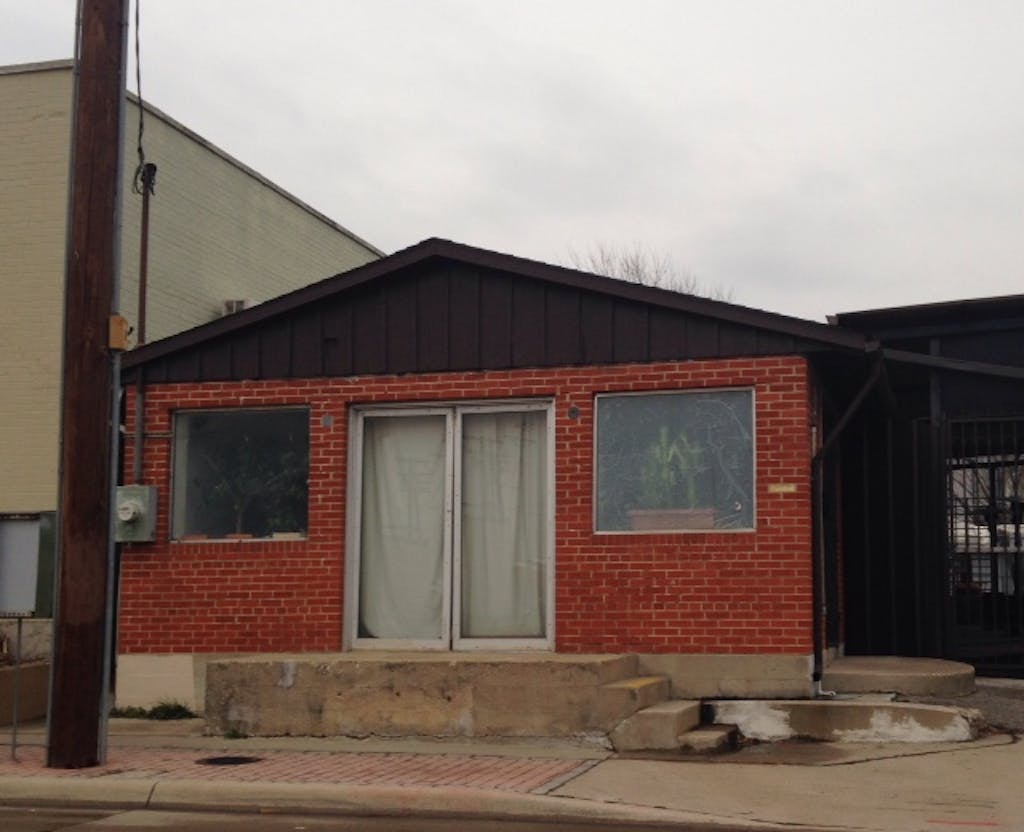
DV: So you moved to that building when it was complete?
BM: Yes. We leased it for fourteen years. Mr. Stanley’s wife passed away and he married another gal. She was some wing-dinger. She got us kicked out of that building in 1982. The story is that she didn’t like my dad and she wanted to open up her own barbecue joint.
DV: Did it ever open?
BM: Yep. It was only open for about a year. Then it became a Mexican food place. That closed and then the XPO Lounge opened up. After that it was the Monkey Bar, and that’s what killed that place. It was a little too loud and all those fancy condos behind there didn’t like that.
DV: What did your dad do when he got kicked out of the Exposition location?
BM: Mr. Powell owned a machine shop down the street and we found out from Bob Buss of East Dallas Automotive across the street here that he owned the land we’re on now. A lot of the people up and down the strip of Main Street were already our customers, so it was a good location. It was two 5000 square foot lots, and he wanted $35,000 for it. Two days later we were at the title company handing over a $15,000 down payment.
Next week I’ll share the completion of the interview where we’ll look at how the life of Mac’s Bar-B-Que transformed in its current location, especially after Billy took over the business from his dad in 1992. We’ll also look at the future of Mac’s as Billy sees it.







